Path Spread
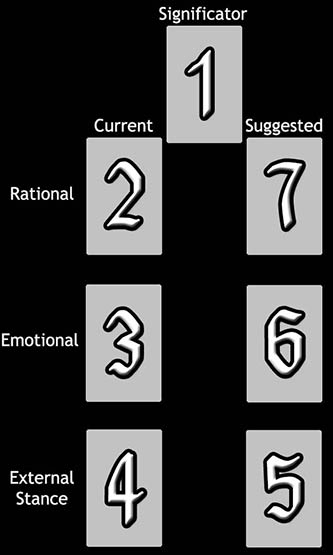
Difficulty: Easy
For the Path reading, one asks for suggestions how to behave properly to achieve a desired result. The Current column represents how the reader has been acting, and the Suggestedcolumn suggests how they should act to achieve a certain goal. The chart-like spread uses the standard three levels: Rational, Emotional, and External Stance (how one projects oneself outwardly). When comparing the Current and Suggested cards, the most important thing is to notice the differences between the two cards. It is these differences which hint at the behaviours that should be altered.
Card #1 is the significator, the card which should reflect the nature of the query and/or the desired outcome.
Card #2 shows the way the reader is and has been thinking. Card #7 suggests how to change the way one thinks to serve themselves better.
Card #3 suggests the reader's emotional attitude. Though it may seem difficult to manipulate one's own emotions, it can be done if one puts their mind to it. For example, acting a certain way such as smiling intently for a few minutes will lead the emotions to follow. When a person tries this, as silly as the exercise seems, they find this to evoke the emotion of happiness. For this reading, one should try to make themselves feel the way that Card #6 suggests.
External Stance means how one acts outwardly, how they hope others see them. Card #4 is about how the reader has been acting, while #5 indicates how they should act outwardly, for other people's sake. It is the differences between these cards that hint at what behaviour patterns should be altered.
Your Path Reading
Current |
The Significator 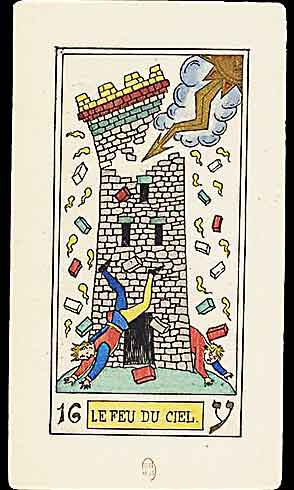 XVI – The Tower |
Suggested |
|
Thought |
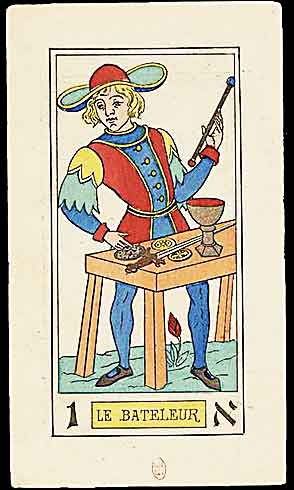 I – The Magician |
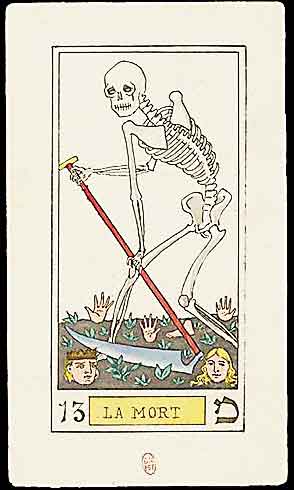 XIII – Death |
|
Emotion |
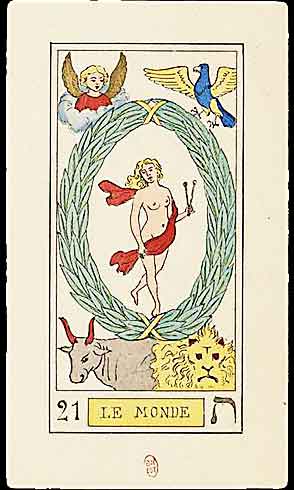 XXI – The World |
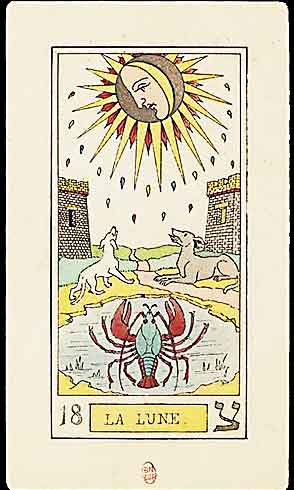 XVIII – The Moon |
|
External Stance |
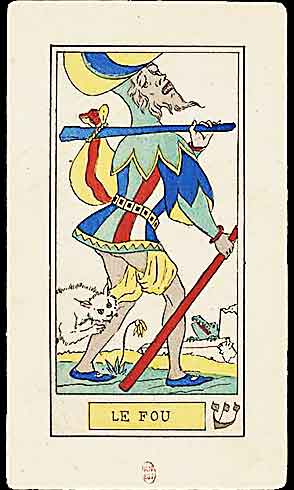 0 – The Fool |
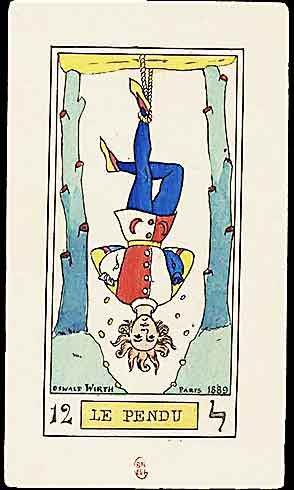 XII – The Hanged Man |

The Significator
XVI – The Tower
The Tower signifies sudden upheaval, revelation, and the breaking down of false structures. This card represents moments of crisis or dramatic change that lead to profound transformation.
Symbolism: The Tower is struck by lightning, causing it to collapse. Figures fall from the tower, symbolising the suddenness and unexpected nature of the event. The crown-like top falling from the tower suggests that pride or false beliefs are being shattered.
In Relationships: A sudden revelation or event that shatters illusions, leading to change or the breakdown of a relationship.
In Work: Unexpected disruption, the destruction of old structures, or a breakdown of outdated systems.
Spiritually: A wake-up call that challenges beliefs or systems, leading to greater clarity and spiritual growth.
When ill-dignified: Crisis, destruction without transformation, or a refusal to accept change.

Current Thoughts
I – The Magician
The Magician signifies mastery, skill, and the power to shape reality. This card represents harnessing resources and directing one's energies towards success. The Magician embodies the potential to manifest desires into tangible form.
Symbolism: He stands before a table with tools representing the four elements: a cup (Water), a sword (Air), a coin (Earth), and a wand (Fire). His raised wand symbolises the connection between spirit and matter, and his hat, shaped like an infinity symbol, signifies endless potential.
In Relationships: A time to use charm, wit, and initiative to build or strengthen relationships.
In Work: Opportunity, success, and the power to manifest goals through skill and action.
Spiritually: The Magician teaches the importance of intention, focus, and using one's talents for higher purposes.
When ill-dignified: Deception, manipulation, or scattered energy. Warning against using one's power for selfish gain.

Suggested Thoughts
XIII – Death
Death signifies transformation, endings, and new beginnings. Rather than literal death, it represents the end of a phase in life, making way for rebirth and regeneration.
Symbolism: Death is portrayed as a skeleton reaping the harvest with a scythe, signifying purification and the promise of growth. Parts of the fallen lie before them, representing what must be left behind for transformation to occur. The card's imagery reminds us that change is inevitable.
In Relationships: An ending or significant change, clearing the way for fresh developments or perspectives.
In Work: The end of a project, job, or phase of life, leading to the start of something new and transformative.
Spiritually: A transformative time where old beliefs or habits must be released for personal growth.
When ill-dignified: Resistance to change, stagnation, or fear of transformation.

Current Emotions
XXI – The World
The World represents completion, fulfilment, and the achievement of wholeness. This card signifies the end of a cycle and the successful realisation of goals and aspirations.
Symbolism: The World features a figure dancing within a wreath, holding two wands. The four corners of the card show the symbols of the fixed signs of the zodiac: the bull, lion, eagle, and man, representing the harmony of the four elements and the completion of the journey.
In Relationships: Harmony, fulfilment, and the completion of a phase of a relationship. The achievement of mutual understanding and goals.
In Work: The successful completion of a project or phase, leading to accomplishment and new beginnings.
Spiritually: The attainment of wholeness, completion, and the alignment of the self with the universe.
When ill-dignified: Complacency, stagnation, or the inability to move forward despite opportunities for growth.

Suggested Emotions
XVIII – The Moon
The Moon signifies illusion, intuition, and the subconscious mind. It represents the mystery of the unknown, hidden fears, and the need to trust inner guidance while navigating uncertainty.
Symbolism: The Moon is depicted with two dogs howling at the moon, symbolising the pull of primal instincts. A crayfish crawls from the water, representing the subconscious emerging into consciousness. The path leads towards a distant horizon, symbolising the journey through confusion to clarity.
In Relationships: Illusions in relationships, emotional confusion, or hidden feelings. Trust your intuition to navigate these uncertain waters.
In Work: Uncertainty or the need to trust your instincts. Hidden factors may influence the situation.
Spiritually: A time to confront fears, listen to your inner voice, and seek clarity in moments of doubt.
When ill-dignified: Deception, illusion, or being misled by false hopes or unclear situations.

Current External Stance
0 – The Fool
The Fool represents freedom, spontaneity, and new beginnings. This card signifies the start of an adventurous journey, full of potential but also uncertainty. He reminds us to embrace the unknown with optimism and an open heart.
Symbolism: The Fool carries a staff and a small sack, symbolising untapped potential and the lessons to be learned. The playful animal at his feet represents instinct, loyalty, and sometimes, the forces that pull us in conflicting directions. His carefree attitude invites a leap into the unknown.
In Relationships: New romantic beginnings, playfulness, and spontaneity, but be wary of impulsive actions.
In Work: A time for exploration, openness to unconventional opportunities, and embracing the unfamiliar.
Spiritually: Embarking on a journey of self-discovery, embracing the unknown with faith.
When ill-dignified: Recklessness, lack of foresight, and the dangers of ignoring consequences.

Suggested External Stance
XII – The Hanged Man
The Hanged Man symbolises suspension, sacrifice, and a shift in perspective. This card represents moments when one must release old beliefs or attachments to gain deeper insight and understanding.
Symbolism: The Hanged Man is depicted hanging upside down, suspended by one foot. His serene expression reflects acceptance and surrender, as he finds wisdom through a change in perspective. His hair resembles a crown symbolising enlightenment and the illumination gained through this pause.
In Relationships: A period of reflection, where relationships may need to be reassessed. It could also suggest a sacrifice for love or personal growth within relationships.
In Work: A time for letting go of old ways of thinking, re-evaluating goals, or waiting patiently for a shift in circumstances.
Spiritually: A time for surrender and spiritual enlightenment, achieved through a different perspective.
When ill-dignified: Stagnation, indecision, or an unwillingness to make necessary sacrifices for growth.